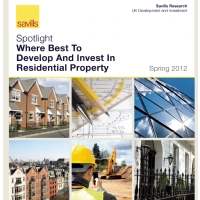Residential property has been the standout investment over the last two decades, outperforming equities, gilts and commercial property over both 10 and 20 years. We have a positive view on the outlook for residential investment as the rental market sector expands, as outlined in our recent special report with Rightmove, Rental Britain (see publications page).
Yield/growth prospects?
Finding future investment performance is a matter of acquiring stock at the right price (and income yield), relative to future prospects for rental and capital growth. As a general rule, property in stronger markets with better growth prospects is priced at a level that generates a lower income yield.
These averages hide a wide range of yields, as shown in Graph 5. This shows gross yields on capital values with vacant possession, so where stock can be acquired at lower ‘investment values’ which can be up to 30% lower, then the yield is significantly more competitive.
The trick is to find opportunities to buy at relatively high yield, where growth prospects are not priced into the market. These acquisition opportunities can occur for a variety of reasons, related to distressed debt and the lack of finance for development, as discussed in the table.
A typical good growth orientated investment proposition is where stock can be acquired in a market with strong growth prospects at a net initial yield of 5.5%, giving the opportunity for meaningful gearing with debt.
Factoring in forecast for rental growth and capital growth over a
10-year period gives a prospective ungeared investment return in excess of 10% per annum and a higher geared return.
Investment opportunities
There are opportunities across the country to buy at high yield but benefit from capital growth in line with lower yielding markets. The most common opportunity is to buy lower grade property in a strong market, or to find micro-markets of different strength in close proximity. Both opportunities are most common in the strongest markets.
Taking London as an example, gross yields on vacant possession values tend to be less than 5% in central London but they move out to above 5.5% in predominantly Zone 2 locations in Camden, Islington, Hackney, Tower Hamlets, Lewisham, and Lambeth.
Furthermore, these boroughs contain large development sites where the funding opportunities in the table opposite are highly relevant. They also contain large swathes of hidden value that can be unlocked by regeneration and investment, as shown in Map 2.
The regeneration of Elephant and Castle in Southwark is a classic example that brings together all of these themes on a grand scale, but there are many others offering more bite-sized opportunities.

.jpg)
.jpg)
.jpg)